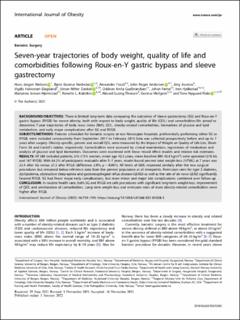Seven-year trajectories of body weight, quality of life and comorbidities following Roux-en-Y gastric bypass and sleeve gastrectomy
Nielsen, Hans Jørgen; Nedrebø, Bjørn Gunnar; Fosså, Alexander; Andersen, John Roger; Assmus, Jörg; Dagsland, Vigdis Halvorsen; Dankel, Simon N; Gudbrandsen, Oddrun Anita; Fernø, Johan; Hjellestad, Iren Drange; Hjermstad, Marianne Jensen; Kolotkin, Ronette Loganzo; Thorsen, Håvard Luong; Mellgren, Gunnar; Flølo, Tone Nygaard
Peer reviewed, Journal article
Published version
Permanent lenke
https://hdl.handle.net/11250/3021638Utgivelsesdato
2022-01-01Metadata
Vis full innførselSamlinger
Originalversjon
International Journal of Obesity. 2022, 46 (4), 739-749. https://doi.org/10.1038/s41366-021-01028-5Sammendrag
Background/objectives: There is limited long-term data comparing the outcomes of sleeve gastrectomy (SG) and Roux-en-Y gastric bypass (RYGB) for severe obesity, both with respect to body weight, quality of life (QOL) and comorbidities. We aimed to determine 7-year trajectories of body mass index (BMI), QOL, obesity-related comorbidities, biomarkers of glucose and lipid metabolism, and early major complications after SG and RYGB.
Subjects/methods: Patients scheduled for bariatric surgery at two Norwegian hospitals, preferentially performing either SG or RYGB, were included consecutively from September 2011 to February 2015. Data was collected prospectively before and up to 7 years after surgery. Obesity-specific, generic and overall QOL were measured by the Impact of Weight on Quality of Life-Lite, Short-Form 36 and Cantril’s ladder, respectively. Comorbidities were assessed by clinical examination, registration of medication and analysis of glucose and lipid biomarkers. Outcomes were examined with linear mixed effect models and relative risk estimates.
Results: Of 580 included patients, 543 (75% women, mean age 42.3 years, mean baseline BMI 43.0 kg/m2) were operated (376 SG and 167 RYGB). With 84.2% of participants evaluable after 5–7 years, model-based percent total weight-loss (%TWL) at 7 years was 23.4 after SG versus 27.3 after RYGB (difference 3.9%, p = 0.001). All levels of QOL improved similarly after the two surgical procedures but remained below reference data from the general population at all timepoints. Remission rates for type 2 diabetes, dyslipidemia, obstructive sleep-apnea and gastroesophageal reflux disease (GERD) as well as the rate of de novo GERD significantly favored RYGB. SG had fewer major early complications, but more minor and major late complications combined over follow-up.
Conclusion: In routine health care, both SG and RYGB are safe procedures with significant long-term weight-loss, improvement of QOL and amelioration of comorbidities. Long-term weight-loss and remission rates of main obesity-related comorbidities were higher after RYGB.

